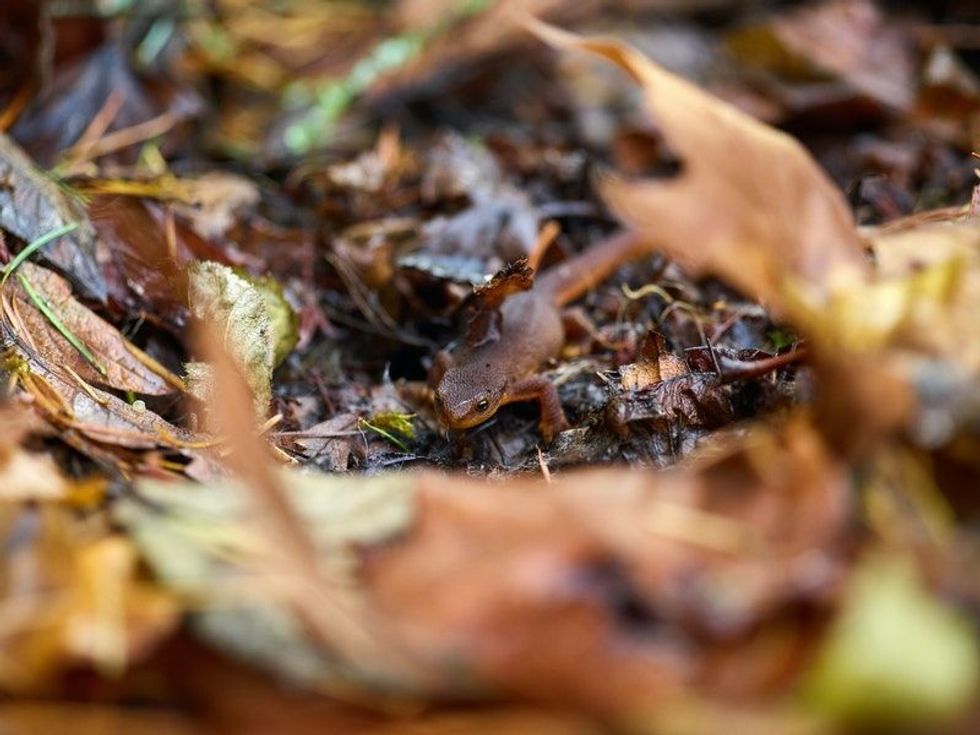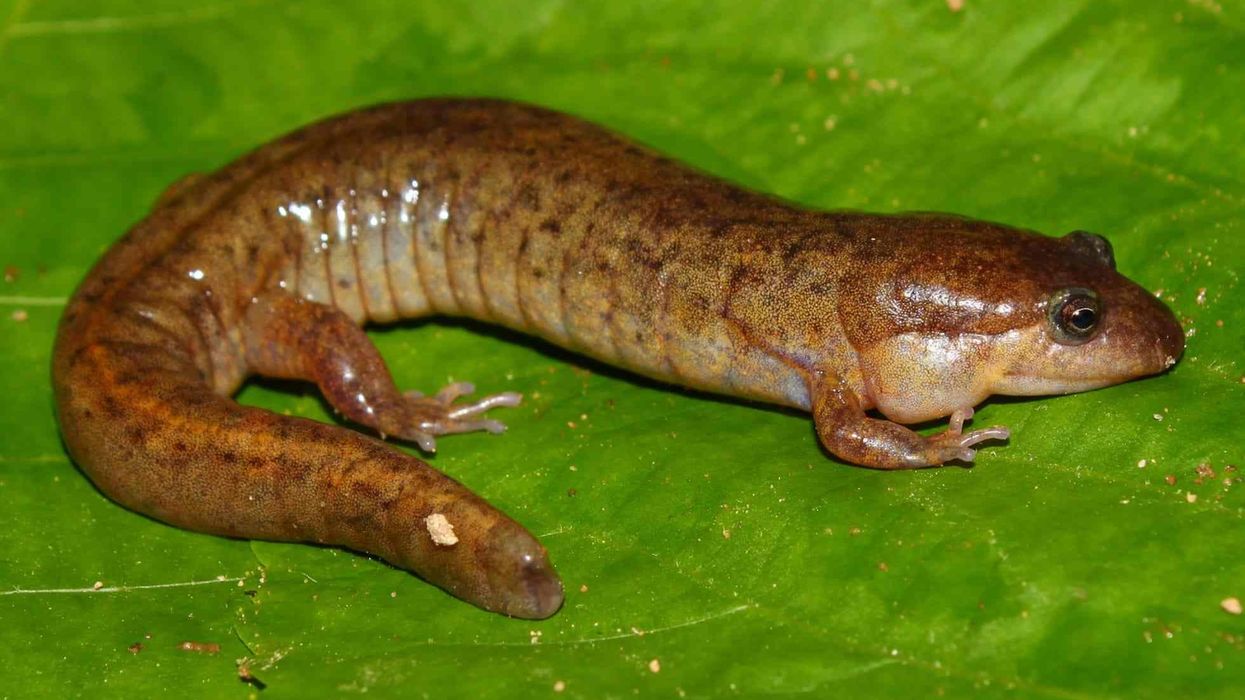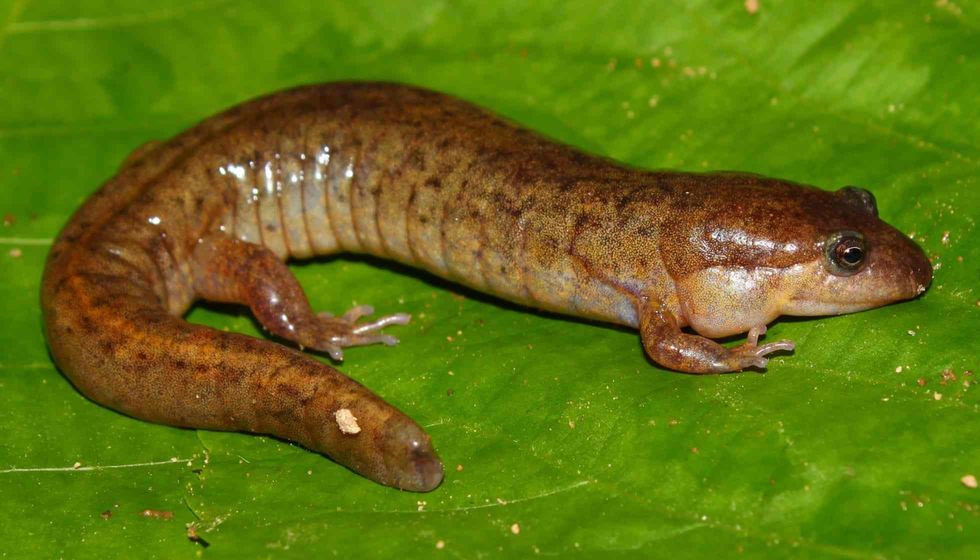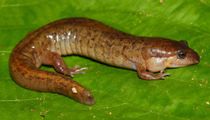Fun Lungless Salamander Facts For Kids

Plethodontidae is a salamander family. Many species of this genus are found in the Western Hemisphere, from British Columbia to Brazil, with a few exceptions in Sardinia, Europe south of the Alps, and South Korea.
They are by far the most numerous group of salamander in terms of species. They are sometimes referred to as worm/dusky salamander.
This is due to their thinner (skinnier) bodies than other salamanders. With approximately 400 species, this is the biggest family of extant salamander and is yet Critically Endangered/Threatened.
The family includes the northern two-lined salamander and red-backed salamander. All members of this family lack lungs and must rely on cutaneous respiration. They also have nasolabial grooves, which help in chemoreception.
This family was originally considered to have evolved in the Appalachian Mountains of eastern North America, which remains a biodiversity hotspot for this family. There are now two subfamilies, the Hemidactylinae and the Plethodontinae, the latter of which contains species capable of ballistically thrusting their tongue to grab prey as well as webbed feet.
Plethodontids are salamanders that have a generalized slender body shape. Over a dozen of them are Plethodon, the most extensive genus in North America.
If you want to learn about other salamanders, check out the marbled salamander and Jefferson salamander.
Lungless Salamander Interesting Facts
What type of animal is a lungless salamander?
The salamanders (Plethodontidae) are part of the salamander species.
What class of animal does a lungless salamander belong to?
The family Plethodontidae of salamander species belongs to the amphibians' class.
How many lungless salamanders are there in the world?
Plethodontidae salamander species have four subfamilies and over 400 species. Some of them are listed as Vulnerable.
Where does a lungless salamander live?
The majority of the salamander species in this genus range on the floors of fragmented forests and woodlands caused by human activity. They like wooded mountain areas.
Bolitoglossa and Pseudoeurycea, two genera found in the New World tropics' mountainous areas, have the greatest diversity in middle-elevation cloud forests; some of the species of this genus, favor nonforested regions and dwell largely in rock crevices in desertlike settings in southern Europe, California, and Baja California. The red salamander is found in the eastern United States.
What is a lungless salamander's habitat?
Plethodontids may be found in forests, arboreal, wooded areas, aquatic areas, streams, springs, and in a cave. They flourish in densely forested mountain regions. Some salamander species exist in deserts where the annual rainfall is less than 10 in (25.4 cm). Others dwell in tropical jungles.
Some of these amphibians are entirely aquatic. Many animals spend all or part of their lives on trees. They reside in North America, Southern Europe, Brazil, Sardinia, California, the Alps, and South Korea, among other places. They have a long tail.
Who do lungless salamanders live with?
Plethodontids are often found in huge groups and are the most abundant vertebrates in a given area. They have restricted home ranges.
The only salamander species that migrate seasonally are those that reproduce in water. Stream-dwelling salamanders are more active than land-dwelling salamanders, although most species can move fast when disturbed and are adept at evading capture.
To escape discovery and capture, land-dwelling animals, particularly tropical species, rely on stealth rather than speed and do not move as rapidly as water-dwelling species. Some of them are aggressive and battle for territory.
How long does a lungless salamander live?
The lifespan of these amphibians varies depending on the species. Salamanders live for around 20 years on average. Some salamander species may survive for up to 50 years. The life span of the same salamander species in the wild and in captivity may even differ. Some of them are Vulnerable or Endangered.
How do they reproduce?
Mating behavior in all lungless salamanders is complicated, and mating can take many hours. More than half of the species are completely terrestrial and deposit enormous eggs that they bury in gaps beneath rocks or logs, moss mats, moss balls hanging in plants, trees, and plants that grow in trees.
These species' eggs hatch weeks after they are deposited, and the young resemble tiny adults. Some salamander species deposit their eggs in or near shallow water, generally flowing water, and the eggs hatch into water-dwelling larvae that take months to three years to transform.
Several Plethodon species spend their whole lives as larvae.
All terrestrial and arboreal plethodontines' embryos develop directly and hatch into adultlike forms. Most species' females protect their eggs.
What is their conservation status?
One species of these amphibians is listed as Extinct by the World Conservation Union (IUCN), 31 as Critically Endangered, 83 as Endangered, 54 as Vulnerable, and 36 as Near Threatened. Two-lined salamander, red-backed salamander, red hills salamander, and dusky salamander (Desmognathus fuscus) are all part of this salamander amphibian species.
Lungless Salamander Fun Facts
What do lungless salamanders look like?
All adult plethodontids have four toes, with the forelimbs having four fingers. Several physical characteristics, such as the disappearance of several cranial bones, also help to identify the group.
However, there is so much variation within this family that it is difficult to find common characteristics that would lead a casual observer to identify a plethodontid: body form ranges from elongate and slender to robust.
Tails can be up to double the length of the body. Plethodontidae comprises some of the tiniest terrestrial salamanders in Thorius, at 1.18 in (30 mm) total adult length, as well as some of the largest with 12.59 in (319.7 mm) body length The head is designed for digging and wedging beneath rocks and in stream beds.
Some salamanders (Plethodontidae) have a long tongue that may be flicked quickly to grab food. Lung-less salamanders that dwell in caves do not have eyes or color, and their limbs and snouts may be unusually shaped.
Other species begin as larvae, but as they develop, their eyes vanish, their eyelids fuse together, and their skin loses its color. Scientists have discovered a huge number of tiny salamanders, mostly in the lung-less salamanders family.
The majority of these slender species spend their whole lives on land, and many of them are quite reclusive.
New species are being found at an alarming rate. Dusky salamanders (Desmognathus fuscus) usually are darker on the back.

*Please note that this is an image of a dusky salamander that belongs to the same family as lungless salamander. If you have an image of a lungless salamander, let us know at hello@kidadl.com.
How cute are they?
Why do certain creatures strike a connection with people, causing them to give millions of dollars to their protection, while others elicit only disgust?
Physical qualities such as large eyes and soft features arouse our maternal instincts since they remind us of human newborns, which is one of the most important aspects of cuteness. The salamanders are an important element of their ecology, much as worms are to the soil health surrounding the steams and lakes where they live; which is almost everywhere.
However, the predominant instinct any amphibian elicits in humans is disgust.
How do they communicate?
All lungless salamanders have a pair of nasolabial grooves that go from the top lip to a nostril. When the salamander taps its snout on a surface, capillary action transports odor particles up the groove and into the sensory cells of the vomeronasal organ of the nose.
Chemical warning cues, food source directions, and cues for courtship and other social behavior are all based on smells in Plethodontidae (lungless salamanders). They may emit foul-tasting chemicals to ward off predators.
How big is a lungless salamander?
The lungless salamanders' family comprises the tiniest and almost the biggest terrestrial salamanders. Thorius is the smallest with a total adult length of 1.18 in (30 mm).
Their tails range in length from modest to lengthy. Many of these species have a body length that ranges between 1-14 in (2.5-35.5 cm) from the tip of the snout to the tip of the tail.
How fast can a lungless salamander run?
Lungless salamanders are quiet during the day and active at night. They have restricted home ranges. The only species that migrate seasonally are those that breed in water.
Stream-dwelling lung-less salamanders are more active than land-dwelling salamanders, although most species are excellent at escaping capture. To avoid detection and capture, land-dwelling species, particularly tropical species, rely on stealth rather than speed and do not move as quickly as water-dwelling species. Some of them are arboreal and cave creatures.
How much do lungless salamanders weigh?
Salamanders' weight typically ranges between 0.26-0.44 lb (118-199.5 g). Giant salamanders may weigh up to 139 lb (63 kg).
What are the male and female names of the species?
There is no distinct name for the males and females of salamander species in accordance with their sex. They are simply called males and females.
What would you call a baby lungless salamander?
The majority of salamanders deposit their eggs in water. When the eggs hatch, the baby salamanders look more like tadpoles than salamanders and are known as salamander nymphs.
What do they eat?
Salamanders consume a wide variety of tiny creatures, including insects, spiders, and worms. They devour a variety of pests, including slugs, mosquito larvae, and flies. They will also devour other salamanders on occasion. Larger species will occasionally consume smaller species. Lungless salamanders catch prey with a powerful flick of their tongue.
Are they poisonous?
Salamandridae members are all toxic, with either poisonous skin or glands that release poison when threatened. In general, the most poisonous skin secretions are found in terrestrial species such as Taricha and the efts of some aquatic species.
Would they make a good pet?
People seldom come upon lungless salamanders. Nevertheless, salamanders are excellent pets that can keep you company for up to 20 years. They don't require a huge aquarium and are very simple to care for, especially because they don't require warmth. You may buy it cheaply or go on a hike along a river or stream and locate one.
Did you know...
The family name (pleth = numerous, dont = teeth) refers to the massive clusters of teeth. The La Palma salamander has five teeth on the premaxilla, 31 on the maxilla, 44 on the dentary, and more than 50 on the vomerine tooth patches. The common worm salamander has the most vomerine teeth, with over 90.
The arboreal salamander is an epidermis-breathing salamander with no lungs. As a result, they are sensitive to changes in water or air quality and serve as effective monitors of ecosystem health.
Climbing salamanders are plethodontid salamanders from the genus Aneides.
Do lungless salamanders have gills?
There are no lungs or gills in terrestrial lungless salamanders, thus respiration/gas exchange occurs mostly via the epidermis. Plethodontids breathe through their skin and the mucous membranes of their mouth and throat, which must always be moist in order to absorb oxygen.
Lunglessness is considered to have developed as a response to living in moving water. Larvae are tiny, and lungs tend to serve as air sacs, causing the salamander to float in the water.
This would cut them off from their food source and endanger their existence. Because the water in a stream is continuously mixed with air, and salamanders can breathe via their epidermis, there is minimal natural selection for maintaining the lung.
Where are lungless salamanders found?
Eastern North America is a global hotspot for lungless salamander species. The brook salamanders are the most indigenous group of lungless salamanders in this region. Except for the north-central regions of these nations, lungless salamanders are found throughout southern Canada, much of the United States, and Mexico.
They're also common throughout Central and South America. The majority of the species are found in the eastern and central United States. Six species are found in Europe's middle western Mediterranean area.
Here at Kidadl, we have carefully created lots of interesting family-friendly animal facts for everyone to discover! For more relatable content, check out these fire salamander facts and green salamander facts for kids.
You can even occupy yourself at home by coloring in one of our free printable lungless salamander coloring pages.
*Please note that the main image is of a dusky salamander which belongs to the same family as lungless salamander. If you have an image of a lungless salamander, let us know at hello@kidadl.com.
We Want Your Photos!
More for You
Bachelor of Fashion Technology specializing in Fashion Merchandising

Shivangi PandeyBachelor of Fashion Technology specializing in Fashion Merchandising
Shivangi is pursuing a Bachelor's degree in Fashion Technology from the National Institute of Fashion Technology. She has a strong passion for the English language and communication, with a keen interest in fashion blogging. Shivangi's educational background and interests complement her ability to create engaging and informative content for readers.
Postgraduate Diploma in Management

Sakshi RaturiPostgraduate Diploma in Management
Sakshi has experience in marketing strategy, social media planning, and recruiting industry experts for capstone projects, she has displayed a commitment to enhancing their skills and knowledge. She has won multiple awards, including a Certificate of Appreciation for Creative Writing and a Certificate of Merit for Immaculate Turut, and is always seeking new opportunities to grow and develop.
Disclaimer
1) Kidadl is independent and to make our service free to you the reader we are supported by advertising. We hope you love our recommendations for products and services! What we suggest is selected independently by the Kidadl team. If you purchase using the Buy Now button we may earn a small commission. This does not influence our choices. Prices are correct and items are available at the time the article was published but we cannot guarantee that on the time of reading. Please note that Kidadl is a participant in the Amazon Services LLC Associates Program, an affiliate advertising program designed to provide a means for sites to earn advertising fees by advertising and linking to Amazon. We also link to other websites, but are not responsible for their content.
2) At Kidadl, we strive to recommend the very best activities and events. We will always aim to give you accurate information at the date of publication - however, information does change, so it’s important you do your own research, double-check and make the decision that is right for your family. We recognise that not all activities and ideas are appropriate for all children and families or in all circumstances. Our recommended activities are based on age but these are a guide. We recommend that these ideas are used as inspiration, that ideas are undertaken with appropriate adult supervision, and that each adult uses their own discretion and knowledge of their children to consider the safety and suitability. Kidadl cannot accept liability for the execution of these ideas, and parental supervision is advised at all times, as safety is paramount. Anyone using the information provided by Kidadl does so at their own risk and we can not accept liability if things go wrong.
3) Because we are an educational resource, we have quotes and facts about a range of historical and modern figures. We do not endorse the actions of or rhetoric of all the people included in these collections, but we think they are important for growing minds to learn about under the guidance of parents or guardians.







